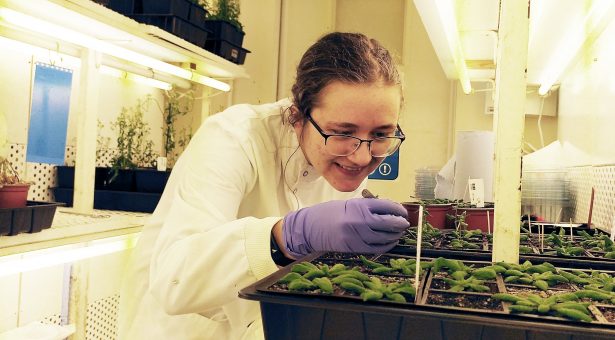Studying plants, from summer school to PhD

Every summer we welcome undergraduates from across the world on our International Undergraduate Summer School which offers the unique opportunity to spend eight weeks here on the Norwich Research Park.
Students experience plant and microbial science, interacting with some of our world-leading scientists and gain an unrivalled insight into research.
We are delighted that Bryony Yates, who attended the summer school in 2018, has returned to the John Innes Centre to start a PhD in plant science in October.
We caught up with Bryony about her experience on the Summer School, what she has been up to since, and her current research project.
“It was the International Undergraduate Summer School that convinced me to do a PhD. I applied to the summer school because I was thinking of doing a PhD but I wasn’t really sure what it was like and I didn’t have any experience in a lab.
I really enjoyed the summer school because it gave me a taste of what research is like. I spent eight weeks working on a research project on how plants sense temperature in the Dean and Howard groups.
One of the most useful things was learning how to grow the model plant Arabidopsis from seed to seed. I never learnt that as an undergraduate, you just get plonked a plant down in front of you for a one-off practical.
Another great thing about the summer school is that it is fully funded with accommodation which takes away any financial stress. The organised social events mean that you have a really fun time too.
During the summer school project, I worked mostly with samples in tubes to study how a specific gene is expressed. This helped me realise that I actually prefer looking at whole plants – not just one gene – and studying them using techniques such as microscopy. That’s why I now study plant development.
The practical experience from the summer school was useful but also one of the most important things I took away was how friendly everyone was and the supportive environment there is here. After the summer school, I knew I would like to come back here at some point because it is a really nice place to work.
The other thing that the summer school made me realise is that I didn’t feel ready to go into a PhD straightaway and I wanted to get a bit more experience in the lab so that I could feel confident starting a PhD working independently.
So, I chose to continue my course at the University of Cambridge as an integrated masters and then afterwards I spent a year working as a Research Assistant at the Sainsbury Laboratory in Cambridge. I did my undergraduate project, masters project and Research Assistant experience in different groups which gave me a range of experiences including working on Hibiscus flowers.
When I started to look for PhDs, the John Innes Centre really appealed to me because of the friendly environment and also because there was such a range of PhD projects in plant science to choose from.
When I was here for the summer school I did a project split between two groups with one side being more computational. Although I didn’t do any modelling on that project – I was mostly in the lab – it gave me a flavour of what the computational side was like through meetings and shadowing.
From that experience, I thought it would be fun to do a project that had a computational element. When the Norwich Research Park Biosciences Doctoral Training Partnership (NRPDTP) projects were advertised, one project really stood out to me for having the computational modelling element from the Dr Richard Smith group combined with the Professor Robert Sablowski group.
I started on the NRPDTP programme in October. The project is looking at stem development in Arabidopsis and there’s a particular group of genes we are interested in. A mutant in one of these genes has a different kind of stem and we are studying how we link these genes to the phenotype we see.
We think there is a mechanical component so that is where the modelling comes in. We want to build a mechanical model of the stem so we can find out what forces are at play and how this affects growth.
I’m at the beginning of my project, so at the moment I’m working on building up materials, such as CRISPR lines and reporter lines.
I’ll be working in Bioimaging a lot because I will be imaging the cells of the stem and how their behaviour changes in response to different treatments and mutations. I’ll use these images to inform my modelling.
I like that the John Innes Centre has such an emphasis on being a welcoming and inclusive place, with active Equality, Diversity and Inclusion initiatives and lots of social events (pandemic permitting). You don’t feel that everything is just focused on your project; there’s other stuff going on too.
Looking ahead, as well as my research project I am excited by the opportunity of the Professional Internships for PhD students, or PIPS, project during my PhD as part of the NRPDTP programme, where you get to experience something different.
As I am only at the start of my PhD, I’m not sure exactly what I want to do afterwards but I think perhaps something involving teaching. I had some experience teaching while I was a Research Assistant in Cambridge and I found it really fulfilling. So I think I would like to stay in science but with teaching element too.”
Bryony is a UKRI-BBSRC Norwich Research Park Biosciences Doctoral Training Partnership (NRPDTP) PhD student.



